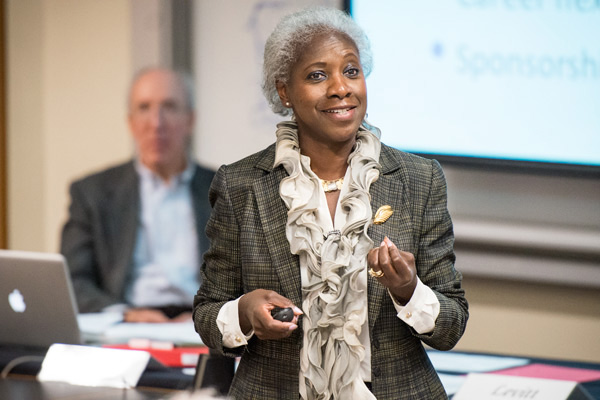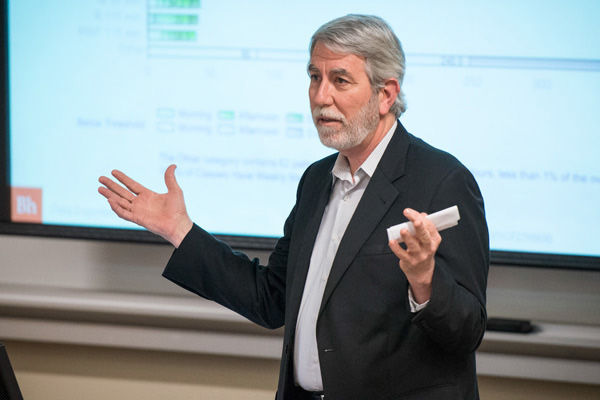Senate addresses classroom scheduling, faculty diversity
At Thursday's Faculty Senate meeting, members heard a report on the challenges of academic room scheduling. There also were presentations on faculty diversity and a report on faculty gains and losses.
University Registrar Tom Black told the Faculty Senate on Thursday that in any given quarter, more than 1,000 undergraduate students at Stanford are enrolled in classes that either have partially overlapping schedules or meet at the same time.
Black presented a slide of one student's Monday-Friday class schedule, which showed that the human biology major was enrolled in a human biology course and a biology course that met on Monday and Wednesday from 11 a.m. to noon.
"At first I thought this was an athlete who was trying to clear out their afternoon, but it was not," Black said. "Then I thought maybe there weren't other sections. That was false as well. So this person chose this schedule. Now the results were disastrous, because in those two courses, this person received a C-minus and a D. In the other courses they received Bs. It's a problem that deserves a look."
While Stanford allows undergraduates to schedule classes that conflict, the Graduate School of Business – with an arguably more mature audience – does not, he said.
It was one of several examples of the negative consequences of Stanford's complex scheduling patterns, Black told the senate at its first meeting of winter quarter.
In assessing Stanford's class scheduling problems, a task he was given a year ago, Black found that one of the main problems was structural – Stanford's complex schedule pattern, which has 26 different "day/class duration" meeting patterns. The other two main problems were university practices: not enforcing existing class schedules and compacting too many courses in the 10 a.m. to 2 p.m. time frame.
Black said an analysis of winter quarter showed there were an additional 63 meeting patterns, for a total of 89 different and potentially conflicting patterns.
In his presentation, Black used slides from a report, Scheduling Block Redesign for Main Campus Classes: Rationale and Proposal Overview, prepared by Biddison Hier, Ltd., a Washington, D.C.-based consulting firm that provides resource planning and management services for public and private universities.
The report noted that the complex schedule also resulted in inefficient use of classroom space, too little coordination among departments and conflicting exams.
"Our goals were to look at this and see if we can solve it; eliminate the overlapping schedule patterns; review our policies, procedures and practices; spread the courses beyond prime time; accommodate special scheduling arrangements; and promote more efficient use of classroom space," Black said.
Black said the proposed changes would affect thousands of people on campus, including students who may resist the idea of early morning classes.
In campus discussions about the proposal, some people have told him the changes would make non-academic meetings and department meetings hard to schedule and also would interfere with the "music hour," where students perform in recitals.
Black said a subcommittee of the Committee on Graduate Studies and the Committee on Undergraduate Standards and Policy will study the report and its recommendations, and present a report to the Faculty Senate during spring quarter.
Report on the faculty
In her presentation to the Faculty Senate on the annual Report on the Faculty: Professorial Gains, Losses and Composition (September 2, 2010, to September 1, 2011), Karen Cook, professor of sociology and vice provost for faculty development and diversity, said the total faculty rose to 1,934 in 2011, compared with 1,900 in 2010.
While Stanford hired 98 new faculty members in 2011, the university recorded the departure of 64 people during the same time period, including 20 faculty members who retired, the report said.
Women constituted 26 percent of the faculty in 2011, compared with 22 percent in 2001.
Underrepresented minorities accounted for 6.9 percent of the faculty in September 2011, the report said. The underrepresented minority faculty roster included 133 people – 51 African Americans (2.6 percent), 75 Hispanics (3.9 percent), four Native Americans (0.2 percent) and three people who fell into the new "two or more races" category. Asian Americans accounted for 15.4 percent of the professoriate, with 297 people.
Ten years ago, underrepresented minorities accounted for 5.9 percent of the faculty, the report said. The underrepresented minority faculty roster included 101 people – 45 African Americans (2.6 percent), 53 Hispanics (3.1 percent) and three Native Americans (0.2 percent). Asian Americans accounted for 10.1 percent of the professoriate in 2001, with 172 people.
"Here's the breakdown by underrepresented minority in the schools," Cook said during her presentation, referring to a slide from the report. "In general, university-wide the numbers have gone up; in some schools they've gone up, in some schools they've stayed about even and in some schools there has not been as much progress as one would perhaps have liked. But some of these schools are fairly small."
In 2011, whites accounted for 77.5 percent of the professoriate, with 1,499 people, compared with 83.9 percent of the professoriate, with 1,426 people, in 2001.
Under the Faculty Development Initiative launched in 2007, Stanford has hired 11 new faculty members – five women and six men – whose research focuses on the study of ethnicity and race. They are working in the Graduate School of Education and in a number of departments in the School of Humanities and Sciences.
"It's been an extremely successful program," Cook said, adding that it was one of several university initiatives designed to build an excellent and diverse faculty.

Senior Associate Dean Dr. Hannah Valantine speaks to the Faculty Senate about initiatives at the Medical Center during the report on the status of women faculty.
The Report on the Faculty contains charts and tables that provide a demographic breakdown of the faculty by gender, race/ethnicity, school and faculty line. Many of the charts and tables contain historical data, allowing readers to compare the makeup of the faculty of September 2011 with the faculties of 2006 and 2001.
It also provides a snapshot of the faculty in all seven schools, including divisions within the Medical School, School of Engineering and School of Humanities and Sciences, as well as a group composed of the SLAC National Accelerator Laboratory, independent laboratories and policy institutes on campus.
Asked by Faculty Senate Chair Ray Levitt to summarize the "best news and the worst news" in the annual report, Cook said:
"If you look at underrepresented minority [URM] faculty increase over the last decade, it's about 1 percent. If we increase the number of URM faculty at the rate of 1 percent a decade, it's going to be a long time before we have something like the diversity that we'd really like to see at Stanford. We just need to be a bit more proactive. It takes all of us. It can't come from the top down."
Cook said that was the same message she gave the senate when she presented the annual report two years ago.
"We would like to see the needle move on that with a concerted effort on all of our parts," she said.
Cook said the good news about women was that they were moving up the ladder.
"They're about 30 percent of the associate and assistant professors," she said.
Diversity and leadership programs at the Medical School
Dr. Hannah Valantine, senior associate dean and director of the Office of Diversity and Leadership at the Medical School, said she is passionate about her work.
"I really believe that Stanford is where it can happen and where we can see major changes in diversity broadly defined, and particularly for advancing women and people from underrepresented groups," she said.
When the Medical School started the Office of Diversity and Leadership in 2005, its strategic goals were organized around increasing recruitment, retention and leadership, Valantine said.
She said the office focused on leadership because the Medical School believed that by identifying future leaders of Stanford and sending them the explicit message that they were going to be supported, the school would improve retention rates.
Valantine showed a slide listing the Medical School's faculty retention programs, which included workshops on grant and scientific writing, research awards, dean's meetings with faculty, a pediatric mentoring program and a child care task force.
"Very few of our programs are specifically for women and that's on purpose," she said, adding that if programs are designed for everyone and are structured appropriately, they are effective for everyone, especially for women.
Valantine said 96 faculty – 45 percent women and 20 percent from underrepresented groups – have completed the yearlong Faculty Fellows Program, a flagship program designed to identify and develop future leaders for Stanford, provide small group mentoring and build community.
"The core of it is a faculty development program in which participating faculty have coaching from our organizational psychologist to be able to better plan their careers and to communicate better with their division chiefs, department chairs, students and staff," she said.
Valantine said 160 faculty – 30 percent women and 10 percent from underrepresented racial/ethnic groups – have completed the Stanford Leadership Program, which was designed to equip faculty with practical leadership and management skills, while also creating a sense of community and reducing feelings of isolation among faculty.
The full minutes of the Jan. 24 meeting, including the question-and-answer sessions that followed the presentations, will be available on the Faculty Senate website next week. The next Faculty Senate meeting will be held Feb. 7.


Share This Story